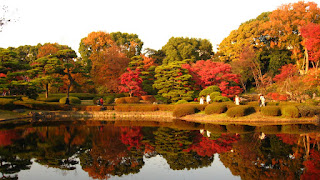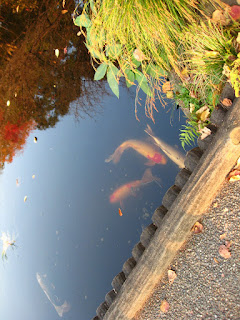
The current imperial palace is located on the same plot of land that the Edo Castle inhabited during the 1600's. In 1868, the capital of Japan was moved from Kyoto to Tokyo and the Palace was completed in 1888. This palace complex was destroyed during World War II and rebuilt in the same style. They Imperial palace is the residency of Japan's Imperial family. Visitors cannot enter the palace buildings or the inner gardens but the surrounding gardens are quite a spectacle.


 The Japanese view of naturals beauty is something to be commented on. Every blade of grass is trimmed uniformly with great precision. The trees are trimmed to exacting specifications with almost a Seussian quality to them. It is so different than the traditional American "rugged is best" look and offers a glimpse into a culture where beauty is in the skillfulness of the craftsman. Plus, those koi in the pond are as big as my arm.
The Japanese view of naturals beauty is something to be commented on. Every blade of grass is trimmed uniformly with great precision. The trees are trimmed to exacting specifications with almost a Seussian quality to them. It is so different than the traditional American "rugged is best" look and offers a glimpse into a culture where beauty is in the skillfulness of the craftsman. Plus, those koi in the pond are as big as my arm.
One of the many intriguing things in the outer gardens of the palace was the statue of Kusunoki Masashige. I was curious about his legacy and why his statue was featured so prominently in the gardens. Further research concludes that Masashige is the epitome of Samurai loyalty. To make a long story short, Masahige was a brilliant tactician that willingly obeyed his Emperor, Go-daigo, and led himself and his armies to certain death due to the emperor's decision. It was interesting that he became sort of a patron saint for Kamikaze Pilots in WWII. His last words during his ritual suicide were reportedly, "Shichisei Hōkoku!" which translates to "Would that I had seven lives to give for my country!"

The most intimidating aspect of the palace were the walls. Constructed of stone, these huge walls ring around the entire complex and end in a deep moat. The construction is incredible and the pictures offer hardly any depth to the austerity and impressiveness they exude when you are there in person.













